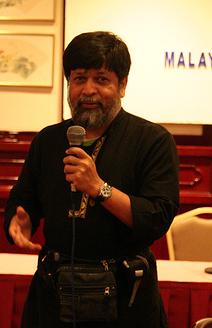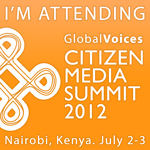Chobi Mela (Picture fair) is a biennial international festival of photography being held in Bangladesh since 2000. Organized by Drik Picture Library Ltd. and Pathshala - South Asian Institute of Photography, this festival showcases the work of Bangladeshi artistes alongside the most exciting works of photographers from the rest of the world.
Sri Lankan photographer Chulie De Silva provides the history of Drik and the Chobi Mela:

The Drik Picture Library was started in 1989 as a small homely business, driven by a need to change the identity of Bangladesh as an icon of poverty and also challenging the western hegemony in photography. “The audacity of it wasn’t an issue. We knew the rules of physics could be bent,” says Shahidul Alam Managing Director and founder talking about the setting up of a world class photo library in the hinterland of photography. It wasn’t that he was not aware of the challenge – but Alam, a pugnacious critic and activist wanted change desperately – a change in how Bangladesh’s story was being told and controlled by the Western media, a change and opportunities for his marginalized people. The story, he strongly believed had to be told by Bangladesh’s own people who understood the issues and felt the pain and suffering of their people.
As with many of Drik’s ventures the first Chobi Mela (Dec.1999-January 2000) was set up on a shoestring budget but has become the most demographically inclusive photo festival in the world. Drik gave space to local photojournalists and emerging artists to share the platform alongside the likes of Salgado, Reza and Parr who had all generously provide their work. The evening seminar sessions were boisterous and vibrant and have become a meeting point for national and international artists.
From Chobi Mela's Wikipedia entry:
Chobi Mela is considered to have the most diverse participation of any such exhibition in the world. While most major festivals are situated in the West or are organised by European organisations, Chobi Mela is unique in having been developed and launched in South Asia and has now gained respectability through the variety and quality of the work exhibited.

On the 21st of January 2011 Chobi Mela VI started offering the itinerary of 29 print exhibitions, mobile exhibitions on 10 rickshaw vans, 33 digital presentations including two films and one play. The opening events were broadcast live via streamed video.
Andrew Hussey captures photos of the traditional march towards the opening ceremony with a marching band, singing and dancing in the street. Here is a video by Jeremiah Foo depicting various events of the exhibition. Shahidul Alam compiles the media mentions about the event.
Photographer and blogger Sabhanaz Rashid Diya writes about the influence of Pathshala students in Chobi Mela:
This year’s Chobi Mela features more students and ex-students from Pathshala than in previous years, and this is only a reflection of the high quality of work that is being produced in the institution. The new breed of photographers is more dynamic and experimental, breaking traditional approaches and encapsulating intimacy and personal connection in their respective stories. [..]
Chobi Mela VI represents a tremendous journey – not only in terms of the festival, its exhibitions and the visiting artists, but also the students of the institution and the art of photography.
Sabhanaz also interviews internationally reputed photographer Pedro Meyer and new generation photographer Sohrab Hura.

Chris Riley shares his experience of attending Chobi Mela by pointing out to the impact of internet distributed media:
The media that defines the future of photography is a digital internet distributed media. It is the hybrid of and tension between the past and future media that will create new work and new forms of photographic storytelling.
The new technologies, as Drik so aptly demonstrates, is changing the audience from being secluded in a region to being global in influence. From Dhaka the stories must be different, they must be from a different perspective and in a different form. This is the Chobi Mela challenge: to emerge into the world and change it. The context for creativity is a large part of creative energy itself.
Another Chobi Mela participant Carlos Cazalis posts "a visual series of images of the mass urbanization occurring in Dhaka and its consequences" in Mega Cities blog.
You can get more information on the exhibition at the Chobi Mela Blog and Shahidul News.
Image Credit:
1) Shahidul Alam, photojournalist and activist, director of Chobi Mela. Image from Flickr by fuzheado. CC BY-SA.
2) Chobi Mela VI at Drik Library. Image from Flickr by Maruf Hossain. CC BY-SA.
Also published in Global Voices Online.
























0 comments:
Post a Comment